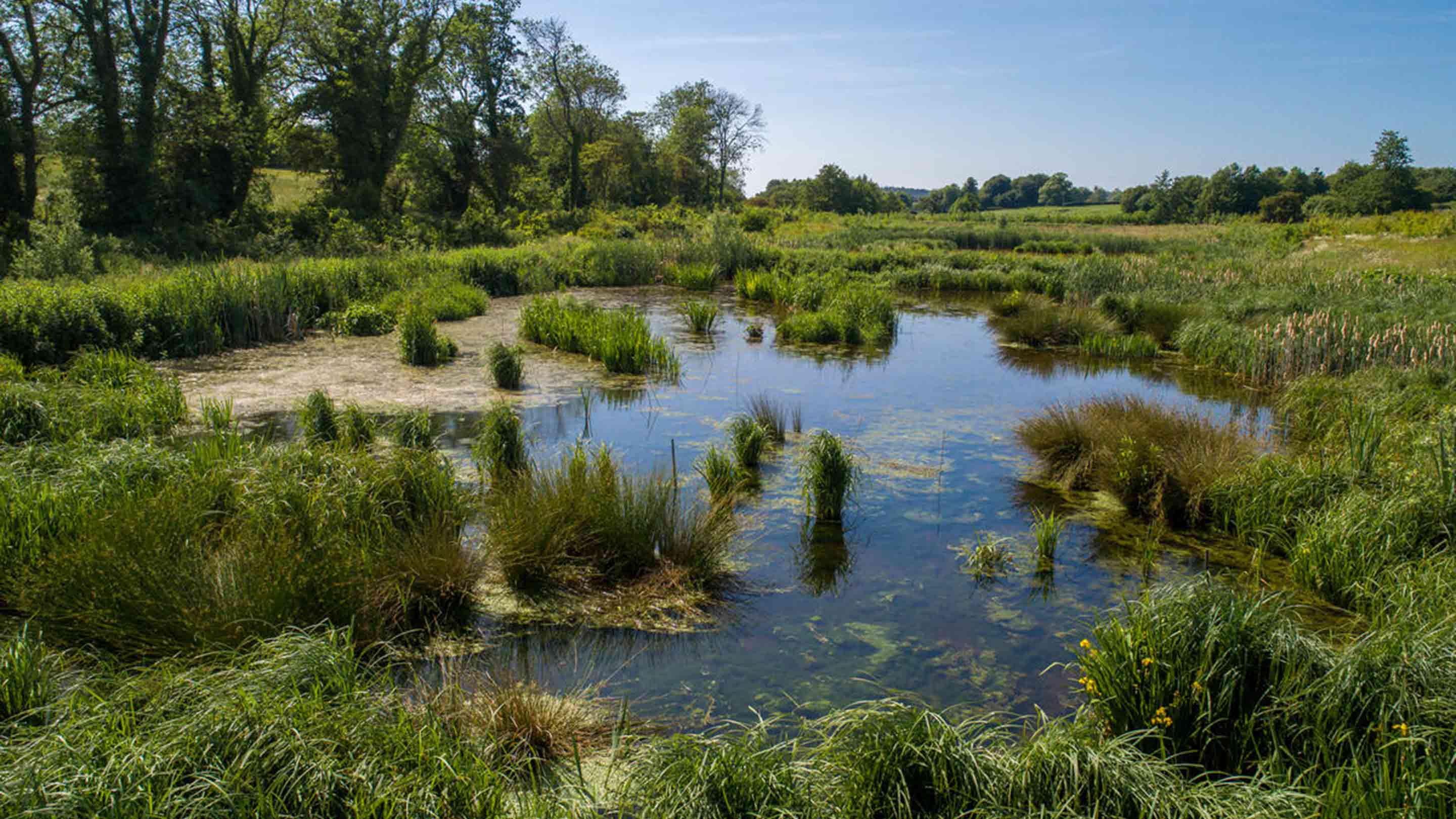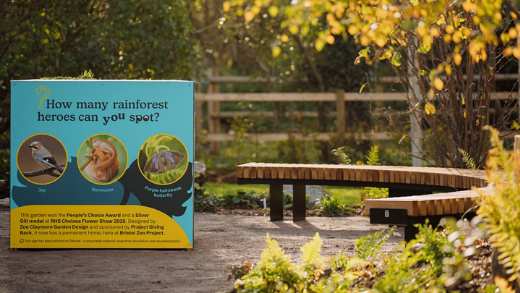
- Small-scale, low-cost flood risk projects implemented by Aviva, Norfolk Rivers Trust and WWF demonstrate a 17:1 return on investment[1].
- 74% UK residents supportive of investment in nature-based solutions to help manage flood risk[2].
- Analysis shows that one in 13 new homes has been built in a flood zone over the past decade.[3]
- Aviva, which has pledged more than £80 million towards nature-based solutions projects, calls for more investment as part of a holistic approach to flood risk management and help homes become climate-ready.
Three new natural flood management systems in Norfolk are already helping to reduce flood risk in the county, according to impact analysis.[1]
The Riverscape East Anglia (EA) project, supported by the WWF and Aviva partnership and delivered by Norfolk Rivers Trust (NRT), aims to increase resilience to flooding in the county. The project has focused on three sites; Gissing and Hempnall in south Norfolk and Edgefield in north Norfolk.
Transcript for video Working with nature to reduce flood impacts
From July to December in 2023, we've seen a huge number of named storms battering a lot of communities.
And with climate change, those numbers will continue to rise.
This will mean higher claims, more disruption for our customers.
And this is why natural flood management projects are quite critical to an organisation such as Aviva.
We're working with WWF in this important area because last year was one of the wettest on record and we see the human impacts of that on our Aviva customers.
Having to move out of their properties, the length of time it can take to repair a property – sometimes 6 to 9 months.
There can also be quite a big impact on their social network and their community.
If a whole street floods, people often have to move out into other properties so they lose contact with their friends, with their relatives, with their neighbours.
In December 2020, we had some catastrophic floods here in the Waveney Valley and in Gissing there were six properties that flooded internally inside those houses.
Two very generous people who owned land in the village offered some of that land to be able to mitigate that flooding and offer a natural solution.
They have land that could be used to capture some of that flood water and try and hold it on the land away from the community.
We came on board and we helped them design some features that could help mitigate some of that flooding.
We're talking leaky dams to slow the flow, scrapes, restoring an old historic channel, essentially just trying to store more water on the land rather than impacting people and their homes.
We've had a really, really wet winter. We haven't seen any homes flooded in that time.
We really hope that some of what we've been able to achieve has contributed to that solution.
The local community have been absolutely behind this.
They've been consulted at every stage through the design and implementation phases.
So, I think they're really grateful.
It's really good to be out here in nature, because we can use the stuff that's around us to stop flooding. People think of flood defenses as big metal gates and concrete and stuff like that.
But actually there's a load of stuff in nature that we can use. And using this, it increases biodiversity.
Having a nature-based solution, it's as simple as picking up sticks to actually build something that can actually stop water from getting into people's houses.
The landscape can hold the water and allow nature a little bit more time to absorb those peaks of flood water.
So it's really simple and easy and cheap to put in place. We're looking at £3,000, £5,000, £6,000. And when you compare that to the cost of replacing somebody's home, it's a tenth of the cost.
And that's just one home.
It really makes sense financially but also ecologically, using nature to its best potential.
Natural flood management projects such as these only attract a really small fraction of the total budget for flood management projects across the UK, and that really needs to change.
And actually, this is where private finance could really ramp up the investment at scale.
The small-scale, low-cost interventions in Norfolk included work to lower the riverbank, installing flood relief channels and leaky dams, planting native hedgerows and replacing culverts. The first of these projects was completed in Gissing in October 2023 with the final work being concluded in Hempnall in December 2024.
Collectively, the three projects in Norfolk help to protect 24 residential buildings in the surrounding villages and, despite storms during the winters of 2023/4, so far there have been no floods in the homes protected by the schemes.[1]
As a low-lying and coastal county, Norfolk is particularly vulnerable to flooding, and according to Aviva’s flood mapping data, it is estimated that over 50,000 properties in the county are at risk from flooding[4]. However, flooding is a risk not only to Norfolk and, worryingly, one in 13 new homes in England has been built in a flood zone in the last decade[3].
Nature-based solutions have an important role to play in the flood management and protection mix and we know there is public appetite for greater awareness and investment in these solutions.
Commenting on the natural flood management project findings, Jason Storah, CEO UK & Ireland General Insurance at Aviva, said: “Though small in scale, these projects have proven effective at protecting homes in small hamlets and villages which might otherwise have flooded during extreme weather. Crucially, they have wider benefits, including attracting wildlife, improving river water quality and providing educational opportunities for local communities.
“Nature-based solutions have an important role to play in the flood management and protection mix and we know there is public appetite for greater awareness and investment in these solutions. In total, these projects cost £43,000 but they have helped to protect 24 homes and provide a 17:1 return on their investment from the cost of restoring flood-damaged homes. Importantly, mitigating flood risks to these homes helps homeowners avoid the devastating impact a flood can bring, providing greater peace of mind when extreme weather hits.”
The research from Aviva also revealed that while consumer awareness of physical flood barriers is high, knowledge of other solutions is lower. Three quarters (77%) of people are aware of sandbags being used to mitigate floods, but over two fifths (45%) have no knowledge of nature-based solutions[2].
However, despite this lack of awareness, as many residents are supportive of investment in nature-based solutions to help reduce the impact of flooding (74%) as those supporting investment in physical flood defence barriers (75%).
Storah adds: “At Aviva, we’re calling for more investment in natural flood management projects to help mitigate climate risk. As these projects have demonstrated, relying solely on physical barriers alone is not enough to protect homes, particularly in smaller villages which may be impacted by urban flooding upstream but are not protected by physical flood defences. We need a holistic approach, combining physical barriers with nature-based solutions and resilience, which will help in making properties climate-ready and reduce the impact of flooding in years to come.”
To deliver flood protection effectively, we need a mix of different interventions, and natural flood management provides a low-cost approach with numerous additional benefits.
Georgia Waye-Barker, Comms and Media Manager at Norfolk Rivers Trust, said: "We’re delighted with how these measures have protected local communities in Norfolk. To deliver flood protection effectively, we need a mix of different interventions, and natural flood management provides a low-cost approach with numerous additional benefits. These measures work best when applied across entire river catchments, creating great impact together. With extreme weather events becoming more frequent due to climate change, we strongly advocate for greater investment to strategically scale up these solutions.”
Across the UK, Aviva has pledged more than £80 million towards nature-based solutions projects which capture carbon, contribute towards flood resilience and help to restore natural habitats.
Details of Riverscape East Anglia projects[1]
|
| Gissing, River Waveney catchment | Hempnall, River Tas catchment | Edgefield, River Bure catchment | Totals |
| Cost | £8,800 | £22,800 | £11,500 | £43,100 |
| Number of properties protected | 6 | 14 | 4 | 24 |
| Potential savings | £180,000 | £420,000 | £120,000 | £720,000 |
| Benefit cost ratio | 1:2 | 1:18 | 1:1 | 1:17 |
-ends-
References:
1 Analysis by Norfolk Rivers Trust of the Riverscape East Anglia (EA) project, supported by WWF and Aviva. In this analysis, costs are defined as the investment needed to make the mitigation measures fully operational. This includes sites visits, mapping and design work, obtaining planning and consent, as well as construction and post-delivery monitoring. Note that subsequent maintenance costs and potential loss of land are not included.
Benefits are defined as the potential damage to properties, modelled in the development phase, that is avoided thanks to the implementation of this measure. As this is hypothetical, an average home flood insurance payout is £30k (source: Aviva). [↑]
2 The research was conducted by Censuswide with 2,022 UK consumers (Nat Rep 16+) including 539 homeowners whose homes have been built within the last five years between 31.07.2024 - 08.08.2024. [↑]
Table 2b (completed homes)
**Live table 320: https://www.gov.uk/government/statistics/land-use-change-statistics-2021-to-2022 [↑]
4 Aviva flood mapping data 2024. [↑]
Enquiries:
Liz Kennett
General Insurance — Products and regulation
-
Phone
-
+44 (0) 7800 692 675
-
-
Email
Notes to editors:
- We are the UK's leading diversified insurer and we operate in the UK, Ireland and Canada. We also have international investments in India and China.
- We help our 25.2m customers make the most out of life, plan for the future, and have the confidence that if things go wrong we’ll be there to put it right.
- We have been taking care of people for more than 325 years, in line with our purpose of being ‘with you today, for a better tomorrow’. In 2024, we paid £29.3 billion in claims and benefits to our customers.
- In 2021, we announced our ambition to become Net Zero by 2040, the first major insurance company in the world to do so. While we are working towards our sustainability ambitions, we recognise that while we have control over Aviva’s operations and influence over our supply chain, when it comes to decarbonising the economy in which we operate and invest, Aviva is one part of a far larger global system. Nevertheless, we remain focused on the task and are committed to playing our part in the collective effort to enable the global transition. The scope of our Climate ambitions and the risks and opportunities associated with our Climate strategy are set out in our Transition Plan published in February 2025: www.aviva.com/sustainability/taking-climate-action. Find out more about our sustainability ambition and action at www.aviva.com/sustainability
- Aviva is a Living Wage, Living Pension and Living Hours employer and provides market-leading benefits for our people, including flexible working, paid carers leave and equal parental leave. Find out more at www.aviva.com/about-us/our-people/
- As at 30 June 2025, total Group assets under management at Aviva Group were £419 billion and our estimated Solvency II shareholder capital surplus as at 30 September 2025 was £7.0 billion. Our shares are listed on the London Stock Exchange and we are a member of the FTSE 100 index.
- For more details on what we do, our business and how we help our customers, visit www.aviva.com/about-us
- The Aviva newsroom at www.aviva.com/newsroom includes links to our spokespeople images, podcasts, research reports and our news release archive. Sign up to get the latest news from Aviva by email.
- You can follow us on:
- X: www.x.com/avivaplc/
- LinkedIn: www.linkedin.com/company/aviva-plc
- Instagram: www.instagram.com/avivaplc
- For the latest corporate films from around our business, subscribe to our YouTube channel: www.youtube.com/user/aviva
















